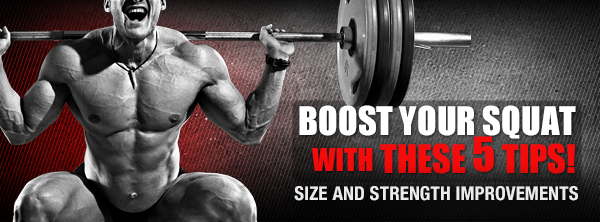
In every realm, there is a king. Basketball has its Lebron James. Bodybuilding has its Phil Heath. Rock n Roll had its Elvis. At any given time, in any sport, business, industry, or location, there is always a king. And there can only be one. It is the mark by which all others are measured, the alpha in a realm packed with betas. Everyone knows the king when they see it.
When it comes to training, without a doubt, the squat is the king of all exercises. It cannot be argued. Sure, bench press grows the arms and chest. Yes, the deadlift will put beef all over your back. But the squat has the unique effect of creating muscle growth in every muscle of the body. There’s an old adage which reads “If you want big arms, you need to squats!” and it is very much accurate. Using squats on a regular basis will create growth hormone release which leads to size and strength improvements in all muscle groups of the body.

Boosting your strength in the squat is of utmost importance if you’d like to maximize your added muscle gains. A stronger muscle is one which is pushed to new levels of performance on a regular basis. Train heavier with each workout, and your muscles will grow progressively larger – and stronger – to accommodate the continually increasing workload. Train with the same weights for a decade, and you’ll look the same for a decade. Train with more weights – even a little bit more weight – each workout, and you’ll discover improvements on a consistent basis. Let’s look at some ways you can boost your squat strength.
Squat earlier in your workout
You know that adding weight to your squat is a key part of adding new strength. And you know from experience that you’re always at your strongest earlier in your workout. As you complete set after set, movement after movement, you begin to lose muscle integrity. With it, balance and control of the weight lessens. This is why most workouts begin with heavy movements of the compound variety, and end with the safe isolation movements. If you’re using squats as your 3rd or 4th movement in a leg workout, placing them behind leg press, lunges, leg extensions, or other movements, then you are short-circuiting your potential strength gains. If your knees are healthy, you should be starting every workout with squats!
Small increments
If you train with the same people for weeks or months at a time, you’ll likely notice they tend to use the same amount of weight for each workout. Yes, 315 is a solid weight for ten perfect squat repetitions. But you’ll never get to 405 for ten perfect repetitions, if you’re always using that same 315 pounds. Most lifters will try to break out of this shell by adding another 25 pound or 45 pound plate to the side, complete 3 to 5 repetitions, and pat themselves on the back for their hard work. Working harder is not the same as working smarter! Adding a one-pound plate to each side of the bar would mean you’re using 317 pounds for ten perfect repetitions. It’s a small gain, but a sustainable one. Add two more pounds to your next workout, and move 319 pounds. Before you know it, the months will have passed and you’ll be squatting 405 pounds for ten perfect repetitions, thanks to small incremental increases to the weekly workload that you probably never even noticed!
Check your alignment
There are many variables at play during a set of squats, even if you don’t realize it. Your leg, hand, feet, knee and body placement can go a long way in determining how effective each set of squats is, at targeting your legs, glutes, hamstrings, and calves for development. Your torso, hands, and your feet should be aligned very evenly, with your back upright and head looking forward as you move through the squat movement. It is only when these parts are in perfect alignment that the body can move the most possible weight, which leads to the greatest possible strength gains. Using poor form on the squats will lead to under-utilization of your muscle groups, which in terms leads to much weaker gains than you would like. Lift correctly – it’s only a few minutes out of your day and it can be the difference between a ten pound gain on your squat in a month, and a very unwanted knee surgery!

Boost your calories
One mistake that many lifters make when attempting to increase their strength is to UNDER-eat. It may seem weird, in a sport dedicated to muscles which include a visible 6-pack, to embrace any idea resembling a daily caloric surplus. However, when one examines the steps of the muscle building process, it quickly becomes apparent that a surplus of calories is an absolute requirement for building new muscle strength from training with the barbell squat, or any exercise. We grow stronger because our muscles grow larger in order to adapt the progressively harder workload to which they are subjected.
Keep those reps tight
Sloppy repetitions lead to average results, when it comes to squats. Practice your groove with every repetition. If you have to lunge or heave the weight to move it, then your muscle fibers aren’t being stimulated. In this case, you are just forcing your back, tendons, hips and other muscle groups to leverage the weight to get through your repetitions. Every repetition should be smooth and controlled, with an obvious adherence to the principles of good form and weight control. Your muscles will be doing the work, and your strength levels will increase as a result!


